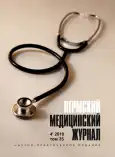Analysis of follow-up observation efficiency criteria
- Authors: Sandakov Y.P.1
-
Affiliations:
- Diagnostic Center № 3 of Moscow Healthcare Department
- Issue: Vol 35, No 4 (2018)
- Pages: 72-76
- Section: Articles
- URL: https://journals.rcsi.science/PMJ/article/view/10332
- DOI: https://doi.org/10.17816/pmj35472-76
- ID: 10332
Cite item
Full Text
Abstract
Aim. To carry out the comparative analysis of follow-up observation efficiency criteria among patients under medical check-up and persons, who had been followed up from the number of those, dead at home.
Material and methods. The age, duration of disease, duration of follow-up observation, real visits to a doctor, rate of exacerbations, emergency calls, hospitalizations were compared in two groups of patients under medical check-up. Group 1 – “dead” – included 100 persons from the number of those, dead at home; group 2 – “alive” – 400 patients, who at the moment of being studied were under follow-up observation. Medical records of ambulatory patients were used as the source of information. The obtained data were analyzed with the method of descriptive and inductive statistics.
Results. In the studied groups, the difference in patients’ mean age was significant t = 3,7 p = 0,0001, the share of persons of the same gender was similar p < 0,01, the difference in men’s mean age was not significant t = –0,21 p = 0,83. The average number of planned (t = 14,2 p = 0,0001) and real (t = 7,4 p = 0,0001) visits to a doctor, exacerbations (t = 9,6 p = 0,0001), emergency calls (t = 7,6 p = 0,0001), hospitalizations (t = 5,2 p = 0,0001), urgent hospitalizations (t = 6,6 p = 0,0001) was significantly higher in the group of “dead”.
Conclusions. The able-bodied men form the risk group regarding unfavorable outcome of noninfectious chronic diseases; follow-up observation does not promote development of loyalty to treatment.
Full Text
##article.viewOnOriginalSite##About the authors
Ya. P. Sandakov
Diagnostic Center № 3 of Moscow Healthcare Department
Author for correspondence.
Email: Sand_2004@mail.ru
кандидат медицинских наук, заместитель главного врача по медицинской части
Russian Federation, 9, Sormovskaya str., Moscow, 109444References
- Богачевская С.А., Богачевский А.Н., Ступаков И.Н., Семенов В.Ю. Значение преемственности оказания медицинской помощи в эффективности работы кардиохирургической службы. Бюллетень НЦССХ им. А.Н. Бакулева РАМН. Сердечно-сосудистые заболевания 2017; 18 (S6): 238.
- Бокерия Л.А., Ступаков И.Н., Гудкова Р.Г., Ватолин В.М. Хирургическое лечение болезней системы кровообращения в Российской Федерации (2010-2014 гг.). Вестник Росздравнадзора 2016; 1: 63-69.
- Диспансерное наблюдение больных хроническими неинфекционными заболеваниями и пациентов с высоким риском их развития: методические рекомендации / под ред. С.А. Бойцова и А.Г. Чучалина. М.: РОПИЗ 2014; 112.
- Комаров Ю.М. Какой должна быть концепция здравоохранения? Главный врач: Хозяйство и право 2011; 5: 9-14.
- Кочубей А.В., Вергазова Э.К. Порядок направления пациентов и финансовое обеспечение высокотехнологичной медицинской помощи. Здравоохранение 2012; 8: 68-73.
- Сабгайда Т.П., Землянова Е.В. Преждевременная смертность и факторы риска как индикаторы программ снижения смертности в России. Социальные аспекты здоровья населения. 2017; 3 (55): 1-25.
Supplementary files






